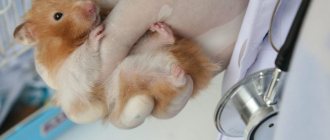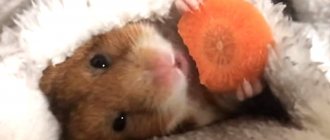03/05/2021 16,191 Hamsters
Author: Olga
Cute, charming fluffy balls - hamsters are quickly winning our hearts. And the one who got such a pet is in vain to think that there will be little trouble with it, because it does not need to be walked or trained. Hamsters also need proper care, because various parasites prey on these animals. Therefore, in order to understand why a hamster itches and what to do in this case, we suggest studying all the possible causes of this unpleasant condition.
[Hide]
Reasons for constant scratching
Needless to say, few people like it when someone constantly bites them. And domestic rodents are no exception. We’ll talk about what can cause severe itching and a situation where hamsters’ hair falls out right now.
Scabies
Scabies can be a possible reason why your hamster is going bald. Scabies is caused by microscopic mites that live in the upper layers of the epidermis or hair follicles. Ticks that parasitize hamsters are conventionally divided into skin beetles, skin beetles and itches. The former feed on keratinized skin and dandruff; the epidermis live directly on the surface of the skin, sucking blood and lymph. Itches live in the upper layer of the skin, make their moves there and feed on the subcutaneous tissue.
Ticks cause a lot of anxiety for the animal. Itches living in the upper layers of the epidermis “clog” it with their metabolic products, which are toxic to hamsters. The result is severe itching, most often in the head and neck area. The animal may try to scratch its body against the bars of the cage. As a rule, scabies is accompanied by severe scratching and wounds, because of this there is a risk of developing concomitant skin inflammation.
The hamster itches and crusts, scabs, and papules are observed on the affected areas of the skin. Remember that hamster mange is highly contagious. Therefore, if several individuals live in your cage, when symptoms appear in one animal, it must be urgently isolated. To confirm the diagnosis, as a rule, a laboratory test is carried out on the animal's hair, which falls out; microscopic mites are not visible to the naked eye.
To treat scabies, you can use Stronghold drops, which are used to treat a similar disease in cats and dogs. You just need to select the dosage very carefully, preferably with the help of a veterinarian.
Demodicosis
Demodicosis is the most common parasitic disease of hamsters. Caused by the activity of the Demodex Aurati mite, which lives in the deeper layers of the skin.
As a rule, it manifests itself as alopecia and an abundance of crusts on bald areas. Most often there are lesions in the chest and lower back. Demodicosis is not always accompanied by itching. Most often, demodicosis can be observed against the background of immune suppression or other concomitant diseases.
The diagnosis of demodicosis is made on the basis of deep scrapings. For treatment, it is optimal to use the drug Ivermectin in very low dosages. Demodicosis is not a contagious disease. However, hamsters may well become infected with feline notoedrosis (essentially the same as scabies). Therefore, be careful when keeping several animals at the same time and monitor the health of each of them. And then in the video you can look at a hamster with traces of demodicosis.
Ectoparasites
Note that external skin parasites, such as fleas or lice eaters, are uncommon in hamsters. Hamsters that have either been in contact with infected individuals or have lived on infected bedding are much more likely to “catch” fleas. For example, if in addition to the hamster you also have cats or dogs in your house, then if they have fleas, you can expect a similar parasite in the rodent.
Fleas traditionally cause severe itching because their saliva contains an irritating substance that the parasite injects into the skin with each bite. Fortunately, fleas are visible to the naked eye, so there are usually no problems with diagnosis. If infected with fleas, a hamster may have quite good general condition and a stable appetite. In some cases, flea bites provoke aggressive behavior in small rodents when they bite and scratch themselves violently.
Sarcoptes anacanthos mites, which cause the disease sarcoptic mange, are considered more dangerous ectoparasites than fleas. Sarcoptic mange is tolerated by hamsters worse than other parasitic diseases. The itching with sarcoptic mange is very strong; the hamster can cause serious wounds to itself with sharp claws. Sometimes the body of a hamster affected by sarcoptic mange looks like one continuous crusty wound with lost hair. This condition is very dangerous for a small animal and can cause its death literally within two weeks.
Allergy
Allergies are not a completely typical situation for hamsters, nor are fleas. Allergens can be food products, especially those that have high nutritional value (oats, corn). In addition, constant feeding of the same product can cause allergies such as skin irritation and itching, and hair loss.
Some hamsters are allergic to bedding, sawdust, dust, or cage cleaner.
In such cases, the animal experiences hair loss, redness of the skin, and watery eyes. If you are allergic specifically to bedding elements, then pay attention to your pet’s paws and belly. Most likely there will be bald spots, areas without fur and redness. Diagnosing allergies is always difficult; first of all, it is necessary to exclude all other causes. After this, you need to do a detailed analysis of the menu and your rodent’s environment, but this does not always help to identify a specific allergen.
Fungal diseases
Fungal diseases are popularly called lichen. However, lichen is extremely rare in hamsters. It is possible, but unlikely, that your animal will contract the fungus Trichophyton mentagrophytes, which could result in the disease trichophytosis. Ringworm, as a rule, does not cause itching; it looks like islands on the skin, completely devoid of hair. There may be redness and peeling on these islands.
To diagnose lichen, scrapings are taken and then inoculated on nutrient media. It should be remembered that lichen is quite contagious. Therefore, you should exclude contact of a sick hamster with other pets and contact it yourself with extreme caution. A person is also not immune from lichen.
Diagnosis and treatment of itching in a hamster
To exclude demodicosis and fungal diseases, a microscopic examination of biological tissue is performed. External parasites can be identified during examination of the animal. Allergic manifestations are more difficult to diagnose due to the variety of allergens.
Read also: Nail design with lips and tongue
Treatment for itching in hamsters depends on the cause of the symptom. Antiparasitic and antifungal drugs are used. In case of allergic manifestation of itching, allergens are excluded, and the animal is transferred to hypoallergenic food.
If you notice that your hamster is constantly itching, contact our Animal World clinic. Veterinary specialists will conduct diagnostic tests, determine the cause of the animal’s itching and prescribe the necessary treatment for your pet.
Prices for veterinary clinic services
| Primary doctor appointment | 300 |
| Secondary doctor's appointment | 200 |
| Primary appointment with a specialist (dentist, dermatologist, ophthalmologist, etc.) | 500 |
| Secondary specialist appointment | 350 |
| Calling a doctor to your home | 1000 |
| Registration passport registration | 60 |
| Chipping | 1000 |
| prices excluding feed and other consumables | |
| Hospital for cats, dogs 3-10 kg 1 day | 350 |
| Hospital for dogs 10-15 kg 1 day | 450 |
| Hospital for dogs 15-20 kg 1 day | 550 |
| Hospitalization for dogs over 20 kg 1 day | 700 |
| Hospital after surgery | 300 |
| Intramuscular, subcutaneous injection | 30 |
| Intravenous injection | 100 |
| Intravenous jet injection | 100-150 |
| Intra-articular injection | 220 |
| Retrobulbar injection | 300 |
| Eye pressure measurement (tonometry) 1 eye | 330 |
| Blood collection | 100 |
| Probing and gastric lavage | 2200 |
| Drip administration of drugs | 200 |
| Drip administration of cytostatics (chemotherapy) | 500 |
| Catheterization of cats and dogs up to 5 kg | 400 |
| Catheterization of males from 5 kg and above | 600 |
| Catheterization of small breed cats and bitches | 600 |
| Catheterization of medium and large breed bitches | 1000 |
| Cystocentesis | 1000 |
| Bathing | 500-3000 |
| Laparocentesis (fluid drainage for ascites) | 500-1000 |
| Treatment of hemolymphatic extravasation | 330 |
| False marigolds | 550 |
| Novocaine blockade | 220 |
| Eye treatment | 50 |
| Treatment for fleas, ticks, etc. | 50 |
| Trimming rodent tooth occlusions | 300 |
| Trimming claws for cats, rabbits and ferrets | 200 |
| Trimming dog nails | 250 |
| Trimming the bird's beak and claws | 200 |
| Trimming incisors in rodents | 100 |
| Ophthalmoscopy (1 eye) | 100 |
| Cleansing enema for cats and dogs up to 10 kg | 600 |
| Cleansing enema for a dog 10-20 kg | 1000 |
| Cleansing enema for dogs from 25 kg | 1500 |
| Oral and rectal administration of drugs | 50-100 |
| Gluing the ears | 250-500 |
| Placement of an intravenous catheter | 200 |
| Bladder lavage | 100 |
| Removing a tick | 100 |
| Removing ticks more than 3 | 50 |
| Subconjunctival injection | 200 |
| Ear cleaning with l/s | 250 |
| Cleaning of paraanal glands (without l/s) | 300 |
| Euthanasia (kitten, rat, etc.) | 500 |
| Cat euthanasia | 1000 |
| Euthanasia of dogs up to 10 kg | 1500 |
| Euthanasia of dogs 10-20 kg | 2500 |
| Euthanasia of dogs over 20 kg | 3000-4000 |
| Fetal resuscitation (1 fetus) | 300 |
| Obstetrics (1 hour) | 500 |
| Pathological obstetrics (1 hour) | 800 |
| Cesarean section for cats | 4500 |
| Caesarean section for bitches up to 10 kg | 5000 |
| Caesarean section for females 10-20 kg | 6500 |
| Caesarean section for females 20-23 kg | 8000 |
| Caesarean section of bitches over 30 kg | 8500 |
| Sanitation of the oral cavity (1 tooth) | 70 |
| Mechanical tartar removal (1 tooth) | 100 |
| Removal of primary canine | 300 |
| Removal of primary incisor | 300 |
| Removal of a permanent tooth | 600-3500 |
| Tooth resection | 1500-2500 |
| Treatment of pulpitis | 1500-5000 |
| Ear and tail docking | 1000-5000 (depending on the age of the animal) |
| Laporotomy | 1500-3000 |
| Mastopathy | 2500-10000 |
| Applying a plaster cast | 600-2000 |
| Application of skin rolls | 500 |
| Treatment of the wound | 150-300 |
| Surgical treatment of cleft palate | 3500 |
| Intestinal surgery in cats | 3500-8000 |
| Intestinal surgery in dogs | 4000-12000 |
| Bladder surgery | 3500-7000 |
| Osteosynthesis | 5000-12000 |
| Surgical placement of the auricle | 300 |
| Eyelid surgery 1 eye | 2500 |
| Eyelid surgery 2 eyes | 5000 |
| Reposition of the lacrimal gland of the third eyelid | 1000 |
| Expansion of the ear canal | 3000-5000 |
| Rectal resection | 3000-5000 |
| Bowel resection | 5000 |
| Removing plaster | 250-1000 |
| Removing stitches | 200-700 |
| Cat sterilization | 2500 |
| Spaying a pregnant cat | 3500 |
| Sterilization of females up to 10 kg | 3500 |
| Sterilization of females 10-20 kg | 4500 |
| Sterilization of females from 20 kg | 7000 |
| Sterilization of female rabbits, ferrets | 3000 |
| Opening an abscess | 800-1300 |
| Velvet paws (2 paws) | 3000 |
| Velvet paws (4 paws) | 4000 |
| Reduction of dislocation of the lower jaw | 1000 |
| Reduction of dislocation | 2000-3000 |
| Reduction of the eyeball | 2500 |
| Gastrotomy | 6000-7000 |
| Removing the pin | 1300 |
| Castration of a cat up to 3 kg | 1300 |
| Castration of a cat over 3 kg | 1500 |
| Castration of a cryptorchid cat | 1500-2000 |
| Castration of a male up to 10 kg | 2000 |
| Castration of a male 10-20 kg | 2500 |
| Castration of a male 20-30 kg | 3000 |
| Castration of a male cryptorchid, category 1 | 3500 |
| Castration of a male cryptorchid, category 2 | 4000 |
| Castration of ferrets, rabbits | 1650 |
| Analysis of blood electrolytes and acid-base balance (K, Na, Cl, iCa,TCa, ph) | 350 |
| General blood analysis | 550 |
| Manual reticulocyte count | 200 |
| Biochemical blood test (price per 1 indicator) | 100 |
| Coagulogram | 1400 |
| Coprogram | 800 |
| Determination of covered blood in stool | 500 |
| Detection of worm eggs, protozoa | 350 |
| Histological examination | 1500 |
| Cytological examination | 1000 |
| General urine analysis | 350 |
| Babesiosis smear | 300 |
| ELISA | 1500 |
| Esophagoscopy | 1700 |
| Esophagoscopy+gastroscopy | 2600 |
| Esophagoscopy+gastroscopy+duodenoscopy | 3200 |
| Colonoscopy | 2800 |
| Biopsy sampling and preservation (+ to the cost of the study) | 500-1000 |
| Removal of a foreign body from the digestive organs (+ to the cost of the study) | 500-1000 |
| Removal of tumors from the digestive organs (+ to the cost of the study) | 1000-1500 |
| Call a specialist to your home | 1000 |
| Initial appointment (examination of the animal, collection of material for research and description of the results, consultation, description of the research results, prescription of a treatment regimen) | 550 |
| Repeated (reception, examination of the animal, collection of material for research and description of the results, repeated consultation and adjustment of the treatment regimen) | 400 |
| Taking a scraping (up to 3 glasses) | 300 |
| Taking cytology (smear, fingerprint smear, scotch test, up to 3 glasses | 400 |
| Taking cytology (TIB/TIAB, up to 3 glasses) | 500 |
| Taking oncocytology (smear, impression smear, TIB/TIAB up to 3 glasses | 1000 |
| Trichoscopy (up to 3 glasses) | 300 |
| Scotch test | 300 |
| Histological examination (surgical manipulation and anesthesiological support are paid separately) | 1500 |
| Wood Lamp Study | 250 |
| Otoscopy | 300 |
| Taking material for PCR testing for dermatophytosis (1 sample) | 900 |
| Taking material for bacteriological and mycological examination with determination of sensitivity to antimicrobial drugs (1 sample) | 1500 |
| Detailed examination of the female/male reproductive tract | 500 |
| Detailed examination of the female/male reproductive tract without conclusion | 350 |
| Abdomen + female/male reproductive tract | 1000 |
| Diagnostics of the abdominal cavity | 700 |
| Abdominal cavity + reproductive tract of female/male without conclusion | 350 |
| Diagnosis of pregnancy | 500 |
| Diagnosis of pregnancy without conclusion | 350 |
| Free fluid diagnostics | 500 |
| Diagnosis of free fluid without conclusion | 350 |
| Diagnostics of the abdominal cavity of a female/male without a conclusion | 350 |
Expand completely
How can I help my fluffy?
The main thing is to pay attention to the itching animal in time. Of course, it will not be possible to diagnose the disease on your own. The first thing you need to do is isolate the itching hamster. The veterinary clinic must take skin scrapings from your pet, possibly fragments of fur, and use them to determine the presence of a particular parasite. If there are no parasites, the hamster may be suspected of having an allergy.
A veterinarian must prescribe drug treatment for a hamster, because due to its miniature size, the animal needs minimal doses of medication, which is not always possible to calculate independently. Stronghold drops are excellent for killing ticks. To get rid of fungus, bathing in special shampoos and treatment with antifungal ointments are suitable. It is imperative to disinfect the cage to destroy tick and flea eggs or fungal spores.
First aid for a pet
If itching occurs, your pet must be given first aid, which includes:
- A special diet that completely excludes sweets and food from the host’s table.
- Including flax seeds in the diet for wound healing.
- Replacing bedding.
- Isolating your pet from other animals.
- Disinfection of the cage and accessories.
- Lubricating the affected areas with linseed or castor oil to soften the scabs.
However, the most reliable way to help your hamster is to show him to a doctor as soon as possible.
Attention! First aid is provided to the hamster before contacting a veterinarian, but in no case replaces it. The goal of first aid is to temporarily relieve symptoms.
Video “Cleaning a hamster cage”
In order to protect your hamster from various parasites and fungi, you need to thoroughly clean his cage. And the video will further tell you how to do it correctly.
Sorry, there are no surveys available at this time.
Was this article helpful?
Thank you for your opinion!
The article was useful. Please share the information with your friends.
Yes (50.00%)
No (50.00%)
X
Please write what is wrong and leave recommendations on the article
Cancel reply
Rate the benefit of this article: Rate the author ( 4 votes, average: 4.75 out of 5)
Discuss the article:
Avitaminosis
The lack of ascorbic acid is especially aggravated during diseases of an infectious or parasitic nature, and sometimes accompanies them. Vitamin deficiency has a detrimental effect on the pet, as the immune system becomes weakened, opening the way to various diseases. Hamsters constantly catch colds and more often suffer severe infections. In acute cases, a lack of vitamin B manifests itself in the form of weakness, the development of anemia and bleeding gums, which become very swollen and painful when touched. If timely treatment is not started, the animal may lose all its teeth. The kidneys also suffer and the joints swell.
To prevent vitamin deficiency, a hamster's diet should always contain a special food with a high content of ascorbic acid. In severe cases, you should not self-medicate your pet. He will need the help of a veterinarian, who will determine his daily dose of vitamin C and prescribe a course of treatment.
Allergy
If your Djungarian hamster is itching, this does not mean that he is sick. Perhaps this is how he manifests an allergic reaction. The cause of itching and scratching can be anything - bedding, food, new products, detergents, air freshener.
When an allergy occurs, the Djungarian hamster not only itches, but also sneezes. The scratches are deep, sometimes ulcers appear on the surface of the skin.
What to do in this case? First of all, you need to exclude newly introduced foods from your diet. If the symptoms do not go away, you need to completely replace your usual diet with a dietary one. You should also move your pet to another cage and change the bedding. The best option in this case would be a layer of napkins or toilet paper. The main thing is that the material is white, without any inscriptions, drawings or flavors.
Allergy
Allergies can be food or contact. A food problem occurs when improper feeding occurs, when the hamster receives food “from the table” - sweet food, nuts, strawberries and other exotic delicacies. Contact – for household chemicals, filler (coniferous sawdust). If the animal sits in the owner's arms, it may be allergic to perfume.
When allergies occur, not only the animal’s skin is affected - the ears turn red, transparent discharge appears from the eyes and nose, and the animal may sneeze.
Treatment does not require the use of antihistamines; it is enough to identify and remove the cause. The bedding is replaced with white paper napkins, and all excesses are removed from the diet.
Ectoparasites
Ectoparasites such as demodex, notoedrosis, sarcoptic mange, and lice eater can cause similar symptoms in decorative rats. These are subcutaneous mites, and the main difficulty is that only a doctor can detect their presence by conducting the necessary research - laboratory tests and scraping of the deep layers of the skin. The appearance of claw marks in the ears and head, as well as the occurrence of dandruff and partial alopecia may indicate damage by ectoparasites.
Treatment
You need to understand that treatment for such lesions takes a long time. It is necessary to treat the animal with antiparasitic solutions, for example, Ivermectin. Independent use of this drug is unacceptable, because It is used for animals of large breeds; for a rat, only a veterinarian can calculate the required dose of medicine. If used incorrectly, it can cause intoxication and subsequent death of the pet. After cure, a repeat analysis (scraping) is necessary. Antiparasitic shampoos are used as a preventive measure.
If you purchased drops that are indicated for cats and dogs to treat skin parasites, do not forget about the dosage.
Allergic reactions
One cannot ignore such an issue as allergies. As a rule, these pets are not particularly prone to them, but the development of an allergic reaction to the components of industrial food is not excluded.
Manifestations of allergies are characterized by:
- itching;
- manifestation of respiratory symptoms (cough, nasal discharge, etc.);
- redness of the conjunctiva and lacrimation.
The basis in the fight against allergies is the elimination of the provoking factor. If you notice the above symptoms in direct connection with changing food, using a new disinfectant, or giving your pet medicinal or preventive nutritional supplements, it is advisable to immediately stop using these products and return to the previous, proven diet.
In any case, if the animal develops problems with the skin or itching, the best solution would be to consult with a specialist.
If you pay attention to your pet’s health in a timely manner, you won’t have to ask the question “The hamster is itching, what should I do?”, and the animal will feel great and delight you for many years.
Secondary alopecia
If the animal suddenly begins to go bald, and the skin looks clean and smooth, the reason is not parasites (mites, fungi). With alopecia that is not caused by problems directly with the skin, the hamster does not itch.
Abscess
If limited purulent inflammation occurs, the skin in this area becomes thinner and the hair falls out. Baldness is accompanied by a change in skin color, the focus fluctuates when palpated. An abscess in a hamster opens spontaneously or in a veterinary clinic.
In addition to surgical treatment, a course of antibiotics and daily washing of the wound with an antiseptic are required. Prescribe “Baytril 2.5%” 0.4 ml per 1 kg of body weight (0.06-0.1 ml for Syrians and 0.02 ml for dwarfs). Subcutaneous injections, 1 time per day, 7 days.
The fur grows back after the purulent inflammation stops.
abscess in a hamster
Urine irritation
If your hamster's hind legs and tummy are bald, this indicates constant skin contact with urine. Infrequent bedding changes and a small cage will cause this phenomenon, but if the pet is kept properly, hair loss on the pelvic limbs is a sign that the hamster drinks a lot and pees a lot. Polyuria is a symptom of various diseases:
- Cystitis (inflammation of the bladder);
- Urolithiasis disease;
- Kidney failure;
- Diabetes (in dwarf hamsters).
hamster urine irritation
Mechanical abrasion of wool
Under unsuitable conditions, thick fur may fall out due to constant mechanical stress. This is how the hair on the paws and tummy is wiped, but most often on the head if the hamster has a bad habit of gnawing on the bars of the cage. The bald spot on the nose will not heal until the pet stops sticking its muzzle through the bars.
If it is not possible to move the rodent from a lattice cage to a terrarium, you need to offer it another object for grinding down its constantly growing incisors. Twigs, treats for hamsters in the form of hard sticks, mineral stone. You should not humanize the animal by thinking that it is gnawing on a cage in order to break free.
Hormonal alopecia
Sometimes, to understand why a hamster is bald, the animal needs an ultrasound. This is not possible in every clinic. An experienced ratologist can assume disruptions in the hormonal system if baldness is observed in a female, and the bald spots on the back are symmetrical. Hamsters have:
- Polycystic ovarian tumors and tumors;
- Endometritis, pyometra (inflammation of the uterus).
hormonal alopecia in a hamster
A female can also go bald during pregnancy. The belly of a nursing hamster becomes completely naked during lactation.
Shedding
Bald spots can be a sign of a natural process for hamsters - seasonal molting. Baldness usually affects the stomach and inner thighs, but sometimes hair falls out on the back.
Old age
If an old hamster begins to go bald, and parasitic diseases are excluded, the true cause can rarely be determined. In such a situation, we can only advise adding special vitamins for rodents to the food and ensuring ideal living conditions.
Shedding
A complete or partial change of coat is called molting. It has two varieties:
- Age - young animals develop denser hair instead of a soft fur coat. The process usually occurs unnoticed by the owner, at the age of about four months.
- Seasonal – associated with the seasons. Spring and autumn molting are most typical for animals. If they hibernate in winter, they shed their fur in summer.
Regarding hamsters, it is impossible to say for sure whether they shed. Of course, the fur is renewed, and if the rodent is healthy, its owner does not even notice it. But in many ways this process depends on hereditary factors and conditions of detention.
If the hamster is healthy, then fur renewal is a completely natural process.
Bacterial and viral diseases of the hamster
Hamsters are very susceptible to diseases caused by pathogenic microorganisms, viruses, and bacteria. Infection is possible by contact, aerogenous, nutritional means, or by eating low-quality feed. Some diseases of bacterial etiology can be transmitted to hamsters from humans and other pets.
Colibacillosis
The infection is caused by Escherichia coli, which parasitizes the gastrointestinal tract of animals. This disease of dzhungarik is also known as “wet tail”, as the sore is manifested by severe diarrhea.
Other symptoms of colibacillosis include:
- decreased, lack of appetite;
- weight loss;
- restless behavior;
- depression, lethargy, apathy;
- drowsiness;
- the presence of wet fur near the anus.
Colibacillosis
Hamster stool with diarrhea has a watery consistency. The hamster constantly curls up into a ball, hides in secluded places in the cage, and looks untidy.
The disease is characterized by an aggressive course and spreads very quickly, therefore, when keeping several animals together in a cage, you must immediately move the sick pet to another home. The disease can be cured only in the early stages of development.
Diplococcosis
An infection of the respiratory tract caused by round microscopic bacteria called diplococci. The main symptoms are lethargy, apathy, decreased activity, discharge from the nose and eyes. If the infection is severe, the dzhungarik refuses food and treats.
The disease requires immediate treatment using special serums. If therapy is not started, the pet’s death occurs on the second or third day.
Salmonellosis
The disease is caused by pathogenic rod-shaped microorganisms - salmonella. With this infection, hamsters experience foamy diarrhea, weakness, apathy, and pale mucous membranes. A sick hamster refuses food, hides in a dark corner, sits motionless, showing no interest in the world around it. The rodent's tummy is enlarged. In the stool you may notice bloody clots, threads, particles of undigested food, and mucus.
Salmonellosis in a hamster
Viral pneumonia
The disease develops against the background of weakened resistance and weakened immune potential. Prolonged hypothermia, chronic otitis, hypo-, avitaminosis can also cause the development of viral pneumonia in animals.
The disease is manifested by abundant mucous, mucopurulent discharge from the eyes, nose, refusal to feed, coughing attacks, and shortness of breath. The hamster has a wet muzzle, hoarse, rapid breathing, and pale mucous membranes. If he shakes his head, his ear, wax has accumulated in the ears, there are crusts and an unpleasant odor emanates, most likely the animal is sick with otitis media, the cause of which is a respiratory illness.
Pneumonia develops against the background of ophthalmological diseases or can provoke eye and ear diseases. With timely treatment, the hamster recovers completely within a week.
Aujeszky's disease
Pseudorabies is a deadly viral disease. The disease manifests itself as severe nervous disorders. The hamster becomes restless and may show aggression. Attacks of excitement are replaced by complete apathy. A sick pet has poor coordination of movements. Muscle spasms and cramps are noted. Death occurs due to paralysis and severe exhaustion. Treatment is carried out with special serums.
Prevention
Prevention of itchy skin in a hamster:
- The pet should receive only high-quality and balanced food and clean water.
- The cage should be cleaned daily.
- Every week the cage and all objects in it are washed with soap and disinfected.
- The temperature in the room where the pet lives should be 18-23 degrees.
- Place the cage in a relatively quiet place so the rodent can sleep during the day.
- If the hamster does not live alone, then each animal needs to have its own secluded place.
- Your pet must have toys, climbing equipment and a running wheel.
Dermatophytosis
A skin disease caused by dermatophyte fungi that feed on hair and dead cells. The infection is also known as ringworm because the red lesions appear in rings on the skin.
There is severe peeling along the edges of the spots, while the surface in the center is absolutely healthy.
Dermatophytosis poses a threat to households - it can be transmitted from animals to humans.
Treatment is selected by a specialist, usually using external agents such as Yam or Fungin ointment, Zoomekol aerosol, chlorhexidine, and sometimes oral medications. The duration of therapy is 1-2 months.
Don’t forget about disinfecting the premises – fungal spores are viable for up to 4 years.
Scab
The causative agent is the fungus Achorion Schoenleini. Hamsters get the disease through contact with sick animals or humans, through insect bites and contaminated equipment.
Scab most often appears in spring and summer.
It looks different depending on the stage of development.
Main symptoms:
- white scaly plaque on the ears, eyebrows and tip of the nose;
- formations are round in shape with a diameter of up to 1 cm;
- Over time, the affected areas become covered with blisters, which gradually increase in size and form crusts with hairs in the middle.
A sick animal must be isolated from other pets, the room and objects with which it has been in contact must be treated with disinfectants.
Establishing an accurate diagnosis will allow the veterinarian to select an antifungal drug, establish the dosage and course of treatment. It is also necessary to treat the affected areas of the skin - scales and scabs should be softened with oils and carefully removed.
Treat areas cleaned of crusts daily with iodine tincture mixed with alcohol solutions of glycerin, creolin or Lysol.
Stress
Hamsters are susceptible to stress. If your hamster itches and your pet's skin and fur look healthy, scratching is a sign of psychological discomfort. When a hamster rubs its back against cage bars and other objects, it marks its territory with its scent. If it seems to you that the dwarf itches often, watch it. A couple of times an hour is not a pathology, but a natural behavior of the animal.
Possible causes of stress:
- moving to a new place;
- proximity to other animals, including relatives;
- frequent change of bedding and washing of the cage, new items in the home;
- disturbance of daytime sleep, loud sounds (TV).
If the pet has recently moved into the house, it should be given a couple of weeks to adapt. You cannot put your hands into the cage while the animal is inside. It is not recommended to take it out of the cage with your hand. Contact between a cautious rodent and its owner should be voluntary.
Knowing why hamsters itch in nature, it is easier to distinguish between pathological itching and the instinctive behavior of a healthy animal. The scent glands of Syrian hamsters are located on the sides, while in dwarf hamsters they are located on the stomach. If a Djungarian hamster scratches its belly on the floor of the cage, it is marking its territory.
Treatment
Diet and conditions of detention
Regardless of the diagnosis, careful dietary instruction is provided. All possible allergens are excluded; flaxseed is given for quick healing of the skin.
The cage and accessories are disinfected, the bedding is replaced with paper towels. Solitary confinement and peace are required.
Fighting the cause
For ectoparasites (fleas, lice, lice), ear and regular scabies, ivermectin or other insecticides are prescribed. For lichen - antifungal drugs. It is important to observe the duration and frequency of prescribed treatments.
What not to do: wet and bathe the animal, self-medicate. Even if you are sure that the animal has parasites, it is better to check the dosage of medications with a doctor. Many medications are toxic to tiny rodents such as the Syrian or Djungarian hamster.
Lichen
This is a skin disease caused by a viral infection or microscopic fungi. Depending on the pathogen, there are two types of lichen: ringworm and pink lichen.
Rodents with weakened immune systems, mechanical trauma to the skin, and elderly animals are at risk of infection.
The following symptoms are typical for lichen:
- baldness;
- the appearance of inflamed areas;
- itching;
- loss of appetite.
If the disease is confirmed, the sick hamster is isolated from other pets, the cage, bowls, wheel and all objects that came into contact with the infected animal are disinfected. The most effective means for this will be a formaldehyde solution or a sulfur-carbolic mixture.
For treatment, antifungal drugs are used, which are prescribed by a specialist, who will also tell you the dosage and duration of the course. Hair is removed from damaged areas of the body as they are contaminated with fungal spores.
Dried crusts are softened and cut off, the area is treated with salicylic ointment, and the edges are treated with iodine. It is also recommended to support your pet’s body with immunostimulating drugs and probiotics during the treatment period.
Ringworm
A characteristic feature is rounded bald patches on the front of the body and muzzle.
Further, these bald spots become inflamed and form purulent ulcers, through which the fungus enters the body, poisoning it with toxins and causing itching throughout the body.
The disease is transmitted from humans to animals and vice versa.
Pityriasis rosea
The main difference from other skin diseases is the appearance of hairless pink areas of skin, more saturated at the edges than in the center.
It is not dangerous for humans - unlike trichophytosis (the scientific name for ringworm), it is not transmitted through household contact.











